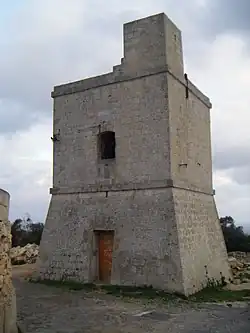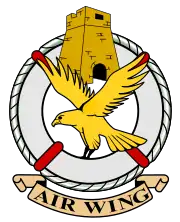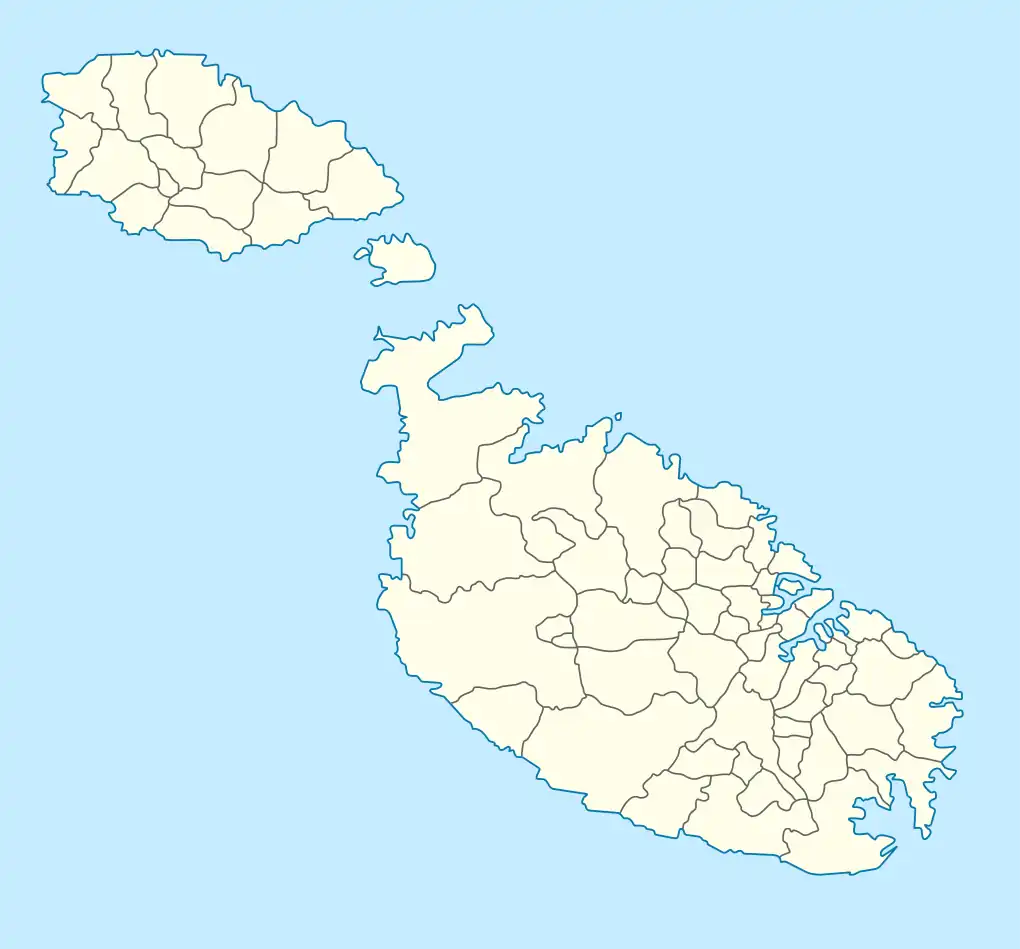| De Redin Towers | |
|---|---|
| Various locations in Malta and Gozo | |
_02_ies.jpg.webp) View of Naxxar's coastline, with three De Redin towers visible (Għallis, St. Mark's and Madliena Towers) | |
| Type | Coastal watchtowers |
| Site information | |
| Condition | 8 intact 2 in ruins 3 destroyed |
| Site history | |
| Built | 1658–1659 |
| Built by | Order of Saint John |
| In use | 1658–1940s |
| Materials | Limestone |
| Battles/wars | Siege of Malta (1798–1800) World War II |
The De Redin Towers (Maltese: Torrijiet ta' De Redin) are a series of small coastal watchtowers built in Malta by the Order of Saint John between 1658 and 1659. Thirteen towers were built around the coast of mainland Malta, eight of which still survive.
The Mġarr ix-Xini Tower, which was built on Gozo in 1661 after the death of de Redin, has a design similar to the De Redin towers.
History
Background and construction

The Spanish knight Martin de Redin was elected Grand Master of the Order of St. John on 17 August 1657. In March 1658, he contributed 6428 scudi[1] for the construction of 13 new watchtowers to strengthen the existing coastal defence system, which consisted mainly of the Wignacourt and Lascaris towers.[2]
The design of the new towers was based on the Sciuta Tower, one of the Lascaris towers, which had been built in Wied iż-Żurrieq in 1638.[3] Each tower had a square base with two floors, with a turret on the roof. The entrance was on the top floor, and was reached by a retractable ladder. The upper room was used as the living quarters for the garrison of four men, while the bottom room was used for storage. Two cannon were mounted on the roof of each tower.
Each tower also had two neighbouring towers in its line of sight, so that signals could be sent from one tower to another, in order to maintain a communication link between Gozo and the Grand Harbour. The signals consisted of smoke or cannon shots by day, or fire by night.[4]
Construction of the first tower, located at Għajn Ħadid in Selmun, began in March 1658, and it was complete within two months. Twelve other towers were built within the following year, with the last tower being complete by July 1659.
In 1661, shortly after the death of de Redin, Mġarr ix-Xini Tower was built on the island of Gozo. Its design is very similar to the thirteen towers and it is sometimes considered to be one of the De Redin towers.[5]
The De Redin towers were the last series of coastal watchtowers to be built in Malta. The only tower built after them was Isopu Tower, which was completed in 1667.[6]
Eighteenth century
In around 1715, as part of a programme to improve Malta's coastal defences, Aħrax Tower and Saint Julian's Tower were upgraded into coastal batteries. A gun platform was built around the seaward face of the tower, which served as a blockhouse. Both batteries still survive, although they are either in a dilapidated state or extensively altered.[4]
Fougasses were dug in the ground near some of the towers in the 1740s. Today, fougasses still exist near Madliena Tower and Saint Mark's Tower. In the 1760s, entrenchments were also built close to some towers, but many of these were demolished in the early 20th century. A small mortar battery was built close to Delimara Tower in 1793.[7]
The De Redin towers did not play a role during the French capture of Malta in 1798, since by this time they were obsolete. However, St. Julian's Tower was involved in the subsequent Maltese uprising, when it was captured by Maltese insurgents.[8]
British period
The upper floor of Għajn Ħadid Tower collapsed on 12 October 1856 during an earthquake, but the ruins of its base have survived to this day.[4]
Most of the other towers were decommissioned in the 19th century. The only exception was Madliena Tower, which was modified to have a role similar to the Martello towers. A battery was built nearby in 1908, and it remained in use until World War II.[9]
In the late 19th or early 20th centuries, the British demolished Bengħisa Tower, Delimara Tower and Żonqor Tower to clear the line of fire of new forts or batteries.[2]
Conservation and restoration
By the end of the 20th century, there were nine surviving De Redin towers. Most of these were intact but rather dilapidated. Triq il-Wiesgħa Tower and Ħamrija Tower were in a very bad state, and were in danger of collapsing.
The first restoration work was carried out by Din l-Art Ħelwa on Għallis Tower and Saint Mark's Tower between 1995 and 1997. Since 2008, Fondazzjoni Wirt Artna has restored Triq il-Wiesgħa Tower and Madliena Tower. Ħamrija Tower was also restored by Heritage Malta, and it now forms part of the Ħaġar Qim and Mnajdra Archaeological Park. The last remaining towers to be restored were Aħrax Tower, restored by Din I-Art Ħelwa in 2021, and Wardija Tower, restored by the Restoration Directorate in 2022.[10][11]
Today, Għallis Tower and Saint Mark's Tower are open by appointment, and Saint Julian's Tower is open as a restaurant.[1]
The towers
| Name | Image | Location | Built | Status |
|---|---|---|---|---|
| Għajn Ħadid Tower |  | Mellieħa | 1658 | Collapsed, 1856 Ruins |
| Għallis Tower |  | Naxxar | 1658 | Intact |
| Saint Mark's Tower |  | Naxxar | 1658 | Intact |
| Madliena Tower |  | Pembroke | 1658 | Intact |
| Saint Julian's Tower |  | Sliema | 1658 | Intact |
| Aħrax Tower |  | Mellieħa | 1658 | Intact |
| Bengħisa Tower | Birżebbuġa | 1659 | Demolished | |
| Xrobb l-Għaġin Tower | Marsaxlokk | 1659 | Ruins | |
| Triq il-Wiesgħa Tower |  | Żabbar | 1659 | Intact |
| Delimara Tower | Marsaxlokk | 1659 | Demolished | |
| Żonqor Tower | Marsaskala | 1659 | Demolished | |
| Ħamrija Tower |  | Qrendi | 1659 | Intact |
| Wardija Tower |  | Żurrieq | 1659 | Intact |
Legacy

Over the years, several structures were built with a design similar to or inspired by the De Redin towers. One of the earliest examples is the Torre dello Standardo, a tower located near Mdina's Main Gate, forming part of the city's fortifications. The tower was used for signalling purposes, to communicate with the coastal watchtowers. It was built in 1725 by the architect Charles François de Mondion, on the site of the medieval Torre Mastra (which also had the same function), as part of a project to restore the city after the 1693 Sicily earthquake. Its design is similar to the De Redin towers, but it is of finer construction, with more importance being given to decorative elements such as escutcheons.[12] Today, the tower is in good condition and is used as a tourist information centre.[13]

Another structure whose design was also similar to the De Redin towers was the Falkun Tower (Maltese: Torri Falkun), located at the Montekristo Estates in Ħal Farruġ, limits of Siġġiewi. This tower, along with other parts of Montekristo Estates, was constructed illegally without the necessary permits.[14] It was supposed to have been demolished in November 2013, but the courts stopped the planning authority MEPA from carrying out the demolition.[15] Since the failed attempt at demolishing the tower and the other illegal structures, new roofing works were carried out on the tower,[16] while more illegal structures were constructed elsewhere in Montekristo Estates.[17] The tower began to be dismantled according to MEPA orders in April 2016.[18] Another tower was built in 2016 in Gozo as a rural structure, similar to the coastal towers but located inland.[19]
Symbols
Armed Forces of Malta


The emblem of the Armed Forces of Malta (AFM) consists of a gold De Redin tower on a red background. The origins of this emblem lie in the AFM's predecessor, the Malta Land Force (MLF). The MLF's emblem originally consisted of a three-dimensional De Redin tower on a French grey background, which was later changed to a red background. This emblem was designed shortly after the founding of the MLF in 1965 by Captain Claude M. Gaffiero. It was retained when the MLF changed its name to the AFM in 1973.[20]
A symbol of a De Redin tower is also featured on pennant of the Commander of the AFM,[21] on the emblem of the Air Wing, on the National Colours, and on various badges of rank.[22]
Malta Stock Exchange

The coat of arms of the Malta Stock Exchange features two gold De Redin towers on either side of the shield, representing security and surveillance.
Pembroke

De Redin towers also feature on the flag and coat of arms of Pembroke, a town on the northern coast of Malta. The coat of arms consists of two crossed swords in the centre, with the thirteen De Redin towers around the border, all in gold on a red background. The sword and towers represent Pembroke's connection with the military, since the town developed out of a British Army barracks that was converted into housing estates.[23][24]
References
- 1 2 "Malta's coastal watch towers". MaltaUncovered.com. 4 December 2009. Retrieved 31 May 2015.
- 1 2 Zammit, Vincent (1992). Il-Gran Mastri – Ġabra ta' Tagħrif dwar l-Istorja ta' Malta fi Żmienhom – L-Ewwel Volum 1530–1680 (in Maltese). Valletta: Valletta Publishing & Promotion Co. Ltd. pp. 234–236.
- ↑ "Wied iz Zurrieq tower gets much-needed clean-out". Times of Malta. 7 September 2014. Retrieved 31 May 2015.
- 1 2 3 Mifsud, Simon (24 December 2012). "Għajn Ħadid Tower and Aħrax Tower". MilitaryArchitecture.com. Archived from the original on 23 August 2017. Retrieved 31 May 2015.
- ↑ Spiteri, Stephen C. (30 March 2010). "Mgarr ix-Xini Tower, Gozo". MilitaryArchitecture.com. Archived from the original on 3 December 2015. Retrieved 31 May 2015.
- ↑ Debono, Charles. "Coastal Towers". Mellieha.com. Archived from the original on 10 May 2015. Retrieved 31 May 2015.
- ↑ "Delimara Gas and Power Combined Cycle Gas Turbine and Liquefied Natural Gas receiving, storage and re-gasification facilities – Environmental Impact Assessment – Appendix Two Volume One" (PDF). MEPA. ERSLI Consultants Ltd on behalf of Enemalta Corporation. 20 December 2013. pp. 26–28. Archived from the original (PDF) on 29 March 2015.
- ↑ Spiteri, Stephen C. (May 2008). "Maltese 'siege' batteries of the blockade 1798–1800" (PDF). Arx – Online Journal of Military Architecture and Fortification (6): 15. Archived from the original (PDF) on 26 November 2016. Retrieved 31 May 2015.
- ↑ Spiteri, Stephen C. (11 August 2010). "Madliena Tower – Malta's 'Martello' Tower". MilitaryArchitecture.com. Archived from the original on 19 October 2015. Retrieved 31 May 2015.
- ↑ "Torri l-Abjad gets a new lease of life after three-year restoration - The Malta Independent". www.independent.com.mt. Retrieved 2022-10-11.
- ↑ "Fantastic news! Zurrieq's 360-year-old Wardija Tower gets FULLY restored". www.guidememalta.com. Retrieved 2022-10-11.
- ↑ "Torre dello Standardo – Mdina" (PDF). National Inventory of the Cultural Property of the Maltese Islands. 28 June 2013. Archived from the original (PDF) on 5 July 2015. Retrieved 4 July 2015.
- ↑ "Info Offices". visitMALTA.com. Retrieved 4 July 2015.
- ↑ Xuereb, Matthew (29 November 2013). "Mepa, armed police swoop on Polidano land – Court puts stop to raid by Mepa". Times of Malta. Retrieved 4 July 2015.
- ↑ "Court stops Mepa demolishing illegal Polidano structures – Government: Abuse will not be tolerated – Entrance blocked by heavy vehicles". Times of Malta. 28 November 2013. Retrieved 4 July 2015.
- ↑ "Montekristo claims illegal sites 'outside' trade fair area". The Malta Independent. 9 July 2014. Retrieved 4 July 2015.
- ↑ Micallef, Mark (3 August 2014). "Illegal development at Montekristo continues". Times of Malta. Retrieved 4 July 2015.
- ↑ "'Falcon Tower', part of Montekristo Estates, being demolished on instruction by Planning Authority". The Malta Independent. 28 April 2016. Archived from the original on 28 April 2016.
- ↑ "Tower rises instead of rubble in Gozo".
- ↑ Attard, David P. "The De Redin Tower". Armed Forces of Malta. Archived from the original on 31 May 2015.
- ↑ "Flags, Symbols and their uses". Government of Malta. Archived from the original on 29 April 2015.
- ↑ "AFM Colours". Armed Forces of Malta. Archived from the original on 4 February 2014.
- ↑ "Informazzjoni ġenerali". Pembroke Local Council (in Maltese). Archived from the original on 31 May 2015.
- ↑ "Village of Pembroke (Malta)". Flags of the World. 9 December 2013. Retrieved 31 May 2015.
Further reading
- Spiteri, Stephen C. (1989), The Knights' Fortifications, Valletta: Book Distributors Ltd.
- Hughes, Quentin (2001), Fortresses of the Knights, Valletta: Said International

